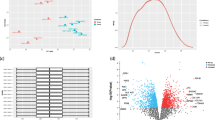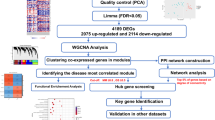Abstract
The purpose of this study is to explore the progression-related genes of diabetic nephropathy (DN) through weighted gene co-expression network analysis (WGCNA). The gene expression dataset GSE14202 was downloaded from the GEO database for differential expression analysis. WGCNA v1.69 was used to perform co-expression analysis on differentially expressed genes. 25 modular genes were selected through WGCNA. The motif enrichment analysis was performed on 25 genes, and 34 motifs were obtained, of which 8 transcription factors (TFs) were differentially expressed. GENIE3 was applied to analyze the expression correlation of 8 differentially expressed TFs and 25 genes. Combined with the predicted TF-target gene relationship, 69 interactions between 8 TFs and 18 genes were obtained. The functional enrichment analysis of 18 genes showed that 7 key genes were obviously enriched in adaptive immune response and were clearly up-regulated in advanced DN patients. The expression of C1S, LAIR1, CD84, SIT1, SASH3, and CD180 in glomerular samples from DN patients was significantly up-regulated in compared with normal samples, and the expression of these genes was negatively correlated with GFR. We observed that in the in vitro cell model of DN, the relative expression levels of 5 key genes (except SASH3) were obviously elevated in the high-glucose group. Five key genes were identified to be related to the progression of DN. The findings of this study may provide new ideas and therapeutic targets for exploring the pathogenesis of DN.








Similar content being viewed by others
Data Availability
The datasets used and/or analyzed during the current study are available from the corresponding author on reasonable request.
Abbreviations
- BP:
-
Biological process
- CC:
-
Cellular component
- DEGs:
-
Differentially expressed genes
- DN:
-
Diabetic nephropathy
- GEO:
-
Gene expression omnibus
- GFR:
-
Glomerular filtration rate
- GO:
-
Gene ontology
- GS:
-
Gene significance
- KEGG:
-
Kyoto encyclopedia of genes and genomes
- MF:
-
Molecular function
- MM:
-
Module membership
- TFBS:
-
Transcription factor binding sites
- TFs:
-
Transcription factors
- TOM:
-
Topological overlap matrix
- TTS:
-
Transcriptional start sites
- WGCNA:
-
Weighted gene co-expression network analysis
References
Advani A, Gilbert RE (2012) The endothelium in diabetic nephropathy. Semin Nephrol 32(2):199–207
Advani A et al (2009) Expression, localization, and function of the thioredoxin system in diabetic nephropathy. J Am Soc Nephrol 20(4):730–741
Anand G et al (2014) Increased IL-12 and decreased IL-33 serum levels are associated with increased Th1 and suppressed Th2 cytokine profile in patients with diabetic nephropathy (CURES-134). Int J Clin Exp Pathol 7(11):8008–8015
Baelde HJ et al (2004) Gene expression profiling in glomeruli from human kidneys with diabetic nephropathy. Am J Kidney Dis 43(4):636–650
Bezhaeva T et al (2017) Deficiency of TLR4 homologue RP105 aggravates outward remodeling in a murine model of arteriovenous fistula failure. Sci Rep 7(1):10269
Burke JA et al (2022) Subcutaneous nanotherapy repurposes the immunosuppressive mechanism of rapamycin to enhance allogeneic islet graft viability. Nat Nanotechnol 17(3):319–330
Coca SG et al (2017) Plasma biomarkers and kidney function decline in early and established diabetic kidney disease. J Am Soc Nephrol 28(9):2786–2793
Conti S et al (2018) Early and late scanning electron microscopy findings in diabetic kidney disease. Sci Rep 8(1):4909
Crown WH (1985) Some thoughts on reformulating the dependency ratio. Gerontologist 25(2):166–171
da Silva EG et al (2018) Clinical data and risk factors for diabetic nephropathy in Brazilian central population. Data Brief 21:1315–1320
Feigerlova E, Battaglia-Hsu SF (2017) IL-6 signaling in diabetic nephropathy: from pathophysiology to therapeutic perspectives. Cytokine Growth Factor Rev 37:57–65
Feng S et al (2021) Identification of lumican and fibromodulin as hub genes associated with accumulation of extracellular matrix in diabetic nephropathy. Kidney Blood Press Res 46(3):275–285
Fiseha T (2015) Urinary biomarkers for early diabetic nephropathy in type 2 diabetic patients. Biomark Res 3:16
Galkina E, Ley K (2006) Leukocyte recruitment and vascular injury in diabetic nephropathy. J Am Soc Nephrol 17(2):368–377
Giacco F et al (2014) Knockdown of glyoxalase 1 mimics diabetic nephropathy in nondiabetic mice. Diabetes 63(1):291–299
Isermann B et al (2007) Activated protein C protects against diabetic nephropathy by inhibiting endothelial and podocyte apoptosis. Nat Med 13(11):1349–1358
Kalantari S et al (2013) Urinary prognostic biomarkers and classification of IgA nephropathy by high resolution mass spectrometry coupled with liquid chromatography. PLoS ONE 8(12):e80830
Kanasaki K (2020) N-acetyl-seryl-aspartyl-lysyl-proline is a valuable endogenous antifibrotic peptide for kidney fibrosis in diabetes: an update and translational aspects. J Diabetes Investig 11(3):516–526
Kanwar YS et al (2011) A glimpse of various pathogenetic mechanisms of diabetic nephropathy. Annu Rev Pathol 6:395–423
Karper JC et al (2013) TLR accessory molecule RP105 (CD180) is involved in post-interventional vascular remodeling and soluble RP105 modulates neointima formation. PLoS ONE 8(7):e67923
Kukuk L et al (2019) Structure of the SLy1 SAM homodimer reveals a new interface for SAM domain self-association. Sci Rep 9(1):54
Langfelder P, Horvath S (2008) WGCNA: an R package for weighted correlation network analysis. BMC Bioinformatics 9:559
Li A et al (2019) Urinary NGAL and RBP are biomarkers of normoalbuminuric renal insufficiency in type 2 diabetes mellitus. J Immunol Res 2019:5063089
Li L et al (2021) Aberrant activation of Notch1 signaling in glomerular endothelium induces albuminuria. Circ Res 128(5):602–618
Lim AK et al (2010) Lymphocytes promote albuminuria, but not renal dysfunction or histological damage in a mouse model of diabetic renal injury. Diabetologia 53(8):1772–1782
Liu H et al (2020) Oncogenic network and hub genes for natural killer/T-Cell lymphoma utilizing WGCNA. Front Oncol 10:223
Matoba K et al (2019) Unraveling the role of inflammation in the pathogenesis of diabetic kidney disease. Int J Mol Sci 20(14):3393
Meyaard L (2008) The inhibitory collagen receptor LAIR-1 (CD305). J Leukoc Biol 83(4):799–803
Moon JY et al (2012) Aberrant recruitment and activation of T cells in diabetic nephropathy. Am J Nephrol 35(2):164–174
Ni WJ, Tang LQ, Wei W (2015) Research progress in signalling pathway in diabetic nephropathy. Diabetes Metab Res Rev 31(3):221–233
Oudit GY et al (2010) Human recombinant ACE2 reduces the progression of diabetic nephropathy. Diabetes 59(2):529–538
Putta S et al (2012) Inhibiting microRNA-192 ameliorates renal fibrosis in diabetic nephropathy. J Am Soc Nephrol 23(3):458–469
Samavat S et al (2015) Diagnostic urinary proteome profile for immunoglobulin a nephropathy. Iran J Kidney Dis 9(3):239–248
Schumaker VN et al (1986) A molecular mechanism for the activation of the first component of complement by immune complexes. Mol Immunol 23(5):557–565
Seo J, Hoffman EP (2006) Probe set algorithms: is there a rational best bet? BMC Bioinformatics 7:395
Tan R et al (2021) Identification of early diagnostic and prognostic biomarkers via WGCNA in stomach adenocarcinoma. Front Oncol 11:636461
Wada J, Makino H (2013) Inflammation and the pathogenesis of diabetic nephropathy. Clin Sci (lond) 124(3):139–152
Walch JM, Lakkis FG (2014) T-cell migration to vascularized organ allografts. Curr Opin Organ Transplant 19(1):28–32
Wang Z et al (2016) Crucial genes associated with diabetic nephropathy explored by microarray analysis. BMC Nephrol 17(1):128
Wang Z et al (2022) Application of weighted gene co-expression network analysis to identify novel key genes in diabetic nephropathy. J Diabetes Investig 13(1):112–124
Wezel A et al (2016) Deficiency of the TLR4 analogue RP105 aggravates vein graft disease by inducing a pro-inflammatory response. Sci Rep 6:24248
Wheelock KM et al (2018) White blood cell fractions correlate with lesions of diabetic kidney disease and predict loss of kidney function in Type 2 diabetes. Nephrol Dial Transplant 33(6):1001–1009
Wu J et al (2015) The relationship between estimated glomerular filtration rate and diabetic retinopathy. J Ophthalmol 2015:326209
Yin L et al (2018) Identification of key pathways and genes in the dynamic progression of HCC based on WGCNA. Genes (basel) 9(2):92
Zhang J et al (2019) Apigenin protects against renal tubular epithelial cell injury and oxidative stress by high glucose via regulation of NF-E2-related factor 2 (Nrf2) pathway. Med Sci Monit 25:5280–5288
Zhang R, Qin L, Shi J (2020) MicroRNA199a3p suppresses high glucoseinduced apoptosis and inflammation by regulating the IKKbeta/NFkappaB signaling pathway in renal tubular epithelial cells. Int J Mol Med 46(6):2161–2171
Zhao S et al (2013) The application of SILAC mouse in human body fluid proteomics analysis reveals protein patterns associated with IgA nephropathy. Evid Based Complement Alternat Med 2013:275390
Zocchi MR et al (2001) Leukocyte-associated Ig-like receptor-1 prevents granulocyte-monocyte colony stimulating factor-dependent proliferation and Akt1/PKB alpha activation in primary acute myeloid leukemia cells. Eur J Immunol 31(12):3667–3675
Funding
This work was supported by the Basic Public Welfare Research Program of Zhejiang Province (Grant No. LY20H070001) and Zhejiang Provincial Medical and Health Science and Technology Program (Grant No. 2020KY1042).
Author information
Authors and Affiliations
Contributions
LY: brought out the original conceptualization, conducted most of the formal analysis and completed the drafting of the manuscript; HT: collected the research data and reviewed & edited the manuscript. All the authors read and approved the final version of the manuscript.
Corresponding author
Ethics declarations
Conflict of interest
The authors have no competing interests to declare that are relevant to the content of this article.
Ethical Approval
Ethics approval was not required for the present study. All sample information is provided from a public database.
Additional information
Publisher's Note
Springer Nature remains neutral with regard to jurisdictional claims in published maps and institutional affiliations.
Supplementary Information
Below is the link to the electronic supplementary material.
Rights and permissions
About this article
Cite this article
Yu, L., Tao, H. Screening of Diabetic Nephropathy Progression-Related Genes Based on Weighted Gene Co-expression Network Analysis. Biochem Genet 61, 221–237 (2023). https://doi.org/10.1007/s10528-022-10250-3
Received:
Accepted:
Published:
Issue Date:
DOI: https://doi.org/10.1007/s10528-022-10250-3




